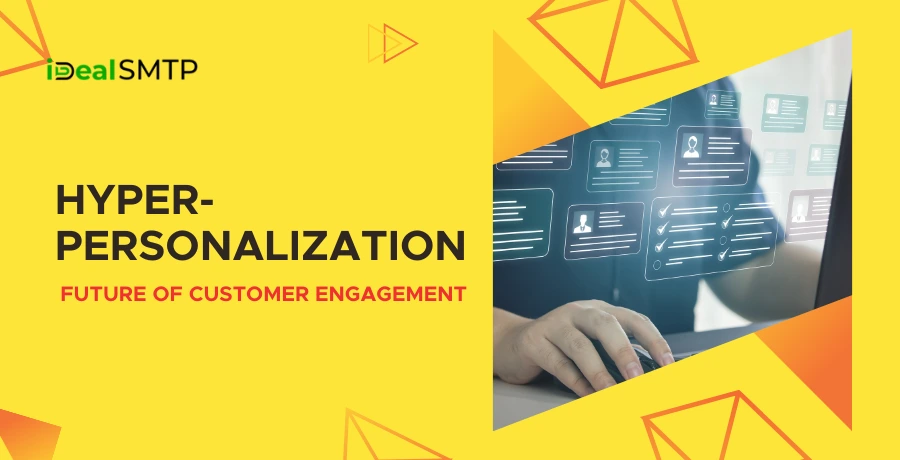The modern digital environment sees businesses increasingly use hyper-personalized marketing to deliver better targeted and engaging communication to their audience. Email marketing now employs hyper-personalization strategies to achieve better customer connections because consumers want deals that align with their interests.

This article examines the unique elements of hyper-personalization marketing alongside its fundamental importance and specific methods to use capable email marketing platforms effectively.
Table of Contents
Pricing
| Trail Plan | Standard Plan | Premium Plan | Professional Plan |
| $50 | $145 | $185 | $225 |
| Sending Limit | Sending Limit | Sending Limit | Sending Limit |
| 1000 Emails/Hour | 1500 Emails/Hour | 3000 Emails/Hour | 5000 Emails/Hour |
Understanding Hyper-Personalization
The approach extends above basic email personalization methods which ordinarily insert the recipient’s name at the start of messages. Organizations can use data analytics with artificial intelligence and machine learning to create content fully adapted for each consumer. Emails become individually personal through hyper-personalization by applying data analysis of customer engagement and behavior patterns alongside previous actions.
Key Elements of Hyper Personalized Marketing
- Dynamic Content- The way emails look depends on specific recipient data points such as where the recipient lives and what they have bought or viewed before.
- Behavioral Triggers- Specific customer actions trigger automated email notifications which include cart abandonment and content download activities.
- Real-Time Data- Up-to-date information enables maintaining relevant content throughout time.
- Predictive Analytics- Companies anticipate their customers’ needs to deliver timely and relevant suggestions.
Why Hyper-Personalization Matters in Email Marketing
Hyper-personalization is transforming email marketing, offering businesses a way to engage with customers on a deeper, more meaningful level. Here’s why it matters:
Enhanced Engagement Rates
Enhanced user engagement rates result from personalized emails which outperform generic communications. Your email marketing campaigns would gain 50% higher open rates from using highly personalized subject lines according to research findings.
Improved Customer Loyalty
Customers become more dedicated to brands they feel companies value and understand their customers’ needs. The feeling of device-to-person connection established through hyper-personalized emails leads customers to buy again and build ongoing relationships with the brand.
Better ROI
Email campaigns driven by hyper-personalization marketing achieve better investment returns through precise audience targeting with specific content delivery timing.
Competitive Advantage
Market saturation makes hyper-personalization an essential tool for businesses to gain substantial market presence. Advanced email marketing services combined with customization power brands to create experiences that give competitive advantages against the competition.
Strategies for Implementing Hyper-Personalization in Email Marketing
Real-time data together with highly developed analytic tools and artificial intelligence provides email marketing with hyper-personalization methodology to provide subscribers with exactly targeted relevant content. Here are some strategies for implementing hyper-personalization effectively:

1. Leverage Customer Data
Hyperpersonalization begins with collecting data as its primary base. Use these methods to gather actionable insights:
- Sign-Up Forms- Obtain determination and likes from users at subscription signup.
- Behavior Tracking- Analyzing user web interaction data together with historic purchase records and email communications provides valuable customer information.
- Surveys and Feedback- Different ways to let users express their preferences include questionnaires and polling.
2. Segment Your Audience
The success of hyper-personalized marketing depends heavily on segmenting your audience. Group your audience based on criteria such as:
- Demographics (age, location, gender)
- Psychographics (interests, values, lifestyle)
- Behavioral data (past purchases, browsing habits)
3. Use Dynamic Content
Your email template plays one role since dynamic content changes it to present a custom design for each person in the audience. Examples include:
- Personalized product recommendations
- Location-specific offers
- Content tailored to the recipient’s browsing history
4. Implement Behavioral Triggers
Behavioral automation tools through automated email messages enhance user engagement performance. Examples include:
- Welcome emails after signing up
- Abandoned cart reminders
- Post-purchase follow-ups
5. Integrate AI and Machine Learning
Through extremely large-scale data analysis AI-powered email marketing services enhance email marketing by building predictive personalization capabilities. Key applications include:
- Predicting future purchases
- Determining the optimal time to send emails
- Crafting personalized subject lines and content
6. Optimize for Mobile Devices
Since most recipients read their emails on mobile devices you should focus on building responsive mobile-friendly design for your emails. All devices must display personalization elements without interruption.
7. Test and Iterate
To determine the best approach for your audience you need to perform A/B testing. To optimize your hyper-personalization approach run tests that measure different subject lines together with content types and call-to-action configurations.
Examples of Hyper-Personalized Email Marketing
Netflix
Through email service campaigns, Netflix demonstrates best practices for highly personalized marketing. User viewing history analysis permits personalized show and movie recommendations which improve user engagement together with retention percentages.
Amazon
Using customer browsing history and shopping patterns Amazon generates tailored product recommendations alongside restocking notifications and targeted promotional deals.
Spotify
The “Wrapped” campaign from Spotify demonstrates excellent standards of highly personalized messaging. The service offers complete breakdowns of consumer audio habits along with a personalized feature that users can share with others.
Benefits of Using Email Marketing Services for Hyper-Personalization
Up-to-date email marketing services provide fully integrated tools for implementing seamless hyper-personalization endeavors. Some of the benefits include:
Advanced Analytics
Through these platforms, users gain access to complete analytical data for both customer engagement and campaign performance tracking.
Automation
Automated workflow systems allow businesses to deliver personalized emails across large customer bases without requiring human hands.
AI Integration
The AI capabilities present in these platforms enable predictive analytics and smart segmentation software to enhance hyper-personalization performance.
Customization Options
Through email marketing service solutions customers can customize their content along with design templates to create dynamic and personalized messages.
Challenges in Hyper-Personalization
While hyper-personalization offers significant benefits, it also comes with challenges:
Data Privacy Concerns
GDPR alongside CCPA has led to new regulations that force businesses to demonstrate compliance throughout their customer data collection and utilization processes.
Data Management
Managing big data amounts poses challenges for businesses. Organizations demand advanced systems that provide efficient solutions for data storage analysis and utilization.
Over-Personalization
Excessive personalization can feel intrusive. Achieving both relevance and privacy should be the essential goal during implementation.
The Future of Hyper-Personalization in Email Marketing
The technological developments of the future will expand the capabilities of hyper-personalized marketing systems. Future trends include:
- Real-Time Personalization- Online data processing innovations will let emails respond automatically whenever users open them.
- Voice-Activated Email- Smart assistants will soon make it possible to interact with emails using voice activation.
- Advanced AI Capabilities- AI technology will become central in creating customized messaging that includes everything from subject header writing to visual design components.
- Integration with Omnichannel Strategies- Hyper personalization will move past standard email boundaries to connect with other marketing channels like SMS texts and social media and push alerts.
Conclusion
Businesses must implement hyper-personalization in email marketing services as this approach moves from a favorable option to the fundamental requirement to build stronger audience relationships. Brands that use advanced email marketing services create personalized experiences that build customer engagement along with increasing loyalty while generating revenue growth.
Success demands businesses achieve the right equation between making optimal use of data and protecting user privacy. The ability to use highly personalized marketing techniques will determine success in upcoming business competition.







